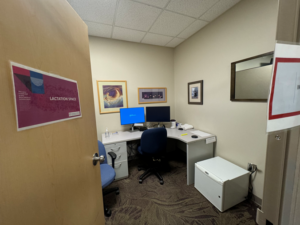Authored by Michelle A. S. Drobny, DO on behalf of AMWA Gender Equity Task Force
I couldn’t believe what I was hearing. A resident physician told me she had decided not to breastfeed because she had heard that pumping at work would be too difficult.
It was a shocking moment for me, especially since I had just started as a new attending at this family medicine residency. One of my biggest goals was to contribute to an environment where residents could focus on learning medicine and providing excellent patient care without unnecessary barriers. That meant ensuring their basic needs were met and creating a psychologically safe learning environment. Hearing this resident’s decision made me realize that something was fundamentally wrong. I made it my mission to figure out why residents felt unsupported in breastfeeding and what could be done to change it.
My Own Experience: Navigating Breastfeeding in Residency
I had my first child during family medicine residency, and to say it was difficult would be an understatement. While my colleagues and program leadership tried to be supportive, I quickly realized that many people didn’t actually know how to be supportive—or they assumed that existing systems were sufficient when, in reality, they often weren’t.
My situation was even more challenging because I returned to work just five weeks after an emergency C-section following a failed induction. I was running around the hospital, admitting patients, managing multiple panels, all while still wearing an abdominal binder. My daughter was too young for daycare, so my husband cared for her while I worked overnight. During the day, I would sleep, wake up to feed her, and pump as much as possible, trying to establish a milk supply that, in hindsight, had never been fully established to begin with.
Pumping at work was a logistical nightmare. Before each new rotation, I would proactively reach out to coordinators to request a space to pump. Sometimes this worked, but often it didn’t. I would arrive on my first day armed with a full arsenal of pumping equipment—battery packs in case I couldn’t find an outlet, a cover for privacy, a car adapter in case I had to pump in my car, and freezer packs because I wasn’t sure if I’d have access to a fridge.
Some situations were particularly bad. During my ACLS training, there was no time built in for pumping, and the only available space was a bathroom without an outlet or even a surface to place my pump. I also recall one instance during a hospital shift when I needed to pump, but a male resident was using the room designated as the pumping space. When I told him I needed the space, he shrugged and said, “Oh, it’s no big deal, I don’t mind.” He kept working on the computer while I tried to discreetly set up my pump—completely uncomfortable the entire time.
By the time I had my second child as an attending, everything was different. I had a private office, a predictable schedule, and enough income to buy a wearable breast pump. Suddenly, pumping was easy, and I realized just how unnecessarily difficult my first experience had been. More importantly, I saw how much better things could be for residents—if only the right systems were in place.
Turning Personal Experience Into Systemic Change
Recognizing the significant barriers residents faced, I turned this into a quality improvement project. Instead of assuming we knew what was needed, I dug in to identify the real problems. The biggest one? There were no dedicated lactation spaces in the clinic or hospital for residents.
Many well-intentioned people thought there were adequate accommodations, but that wasn’t the reality. I conducted a thorough audit of all designated lactation spaces, assessing whether they had the bare minimum essentials:
– A lockable door
– True privacy (no uncovered windows)
– An electrical outlet for traditional breast pumps
Ideally, these spaces would also have access to a fridge, a surface for the pump, and a workstation—because, realistically, residents aren’t given 15-minute breaks where they can sit and do nothing. If pumping meant falling behind on work, that itself would be another deterrent.
Once we had all the data, we presented it to hospital leadership. As a result, we were able to secure:
-A dedicated lactation space in the clinic
-A dedicated lactation space in the hospital
-Wearable breast pumps (around $400) for residents to borrow if they couldn’t afford one or if their insurance didn’t cover it
The Impact
The results of these changes were profound:
– Breastfeeding duration increased. Residents were able to meet and even exceed their breastfeeding goals.
– The time it took to find a place to pump decreased. Less time wasted meant less stress.
– Residents felt less judged. Their perception of how faculty and program leadership viewed the decision to breastfeed improved.
More broadly, these changes contributed to a culture where residents felt more supported in their personal and professional lives. When systemic barriers are removed, it improves not just individual wellness but also equity within the program.
Lessons Learned: The Power of Intentional Support
I’m incredibly proud of the work we’ve done, this experience reinforced an important lesson, that good intentions aren’t enough. It’s easy to assume that a wellness initiative is working, but without regular evaluation, things fall through the cracks. Residents may not always recognize when they’re struggling—or they may assume their struggles are just part of the job. That’s why we need to be proactive in advocating for them. Creating an optimal learning environment isn’t just about teaching medicine. It’s about ensuring that residents can fully engage in their training without unnecessary stressors getting in the way. Whether it’s lactation support, parental leave, or other wellness initiatives, we must ask:
– Are our current policies truly meeting residents’ needs?
– Are there hidden barriers we haven’t considered?
– Are we actually listening to the people these policies are meant to help?
By taking a critical look at our systems and making targeted improvements, we can create an environment where residents don’t have to choose between personal needs and professional success. Because no one should feel like they must give up breastfeeding just because their workplace makes it too hard.
About the Author
 Michelle A. S. Drobny, DO
Michelle A. S. Drobny, DO
Originally from Medford, Oregon, Dr. Drobny earned her Bachelor of Science in Biology from Washington State University and then attended medical school at Western University of Health Sciences, COMP-NW in Lebanon, Oregon. After graduation, she completed her residency at the Puyallup Tribal Health Authority in Tacoma, Washington. She is currently serving as Associate Program Director at Family Medicine Residency Spokane. She believes in a thorough approach to primary care and that the best patient outcomes depend on building strong, personal connections with patients and focusing on continuous learning and improvement.
